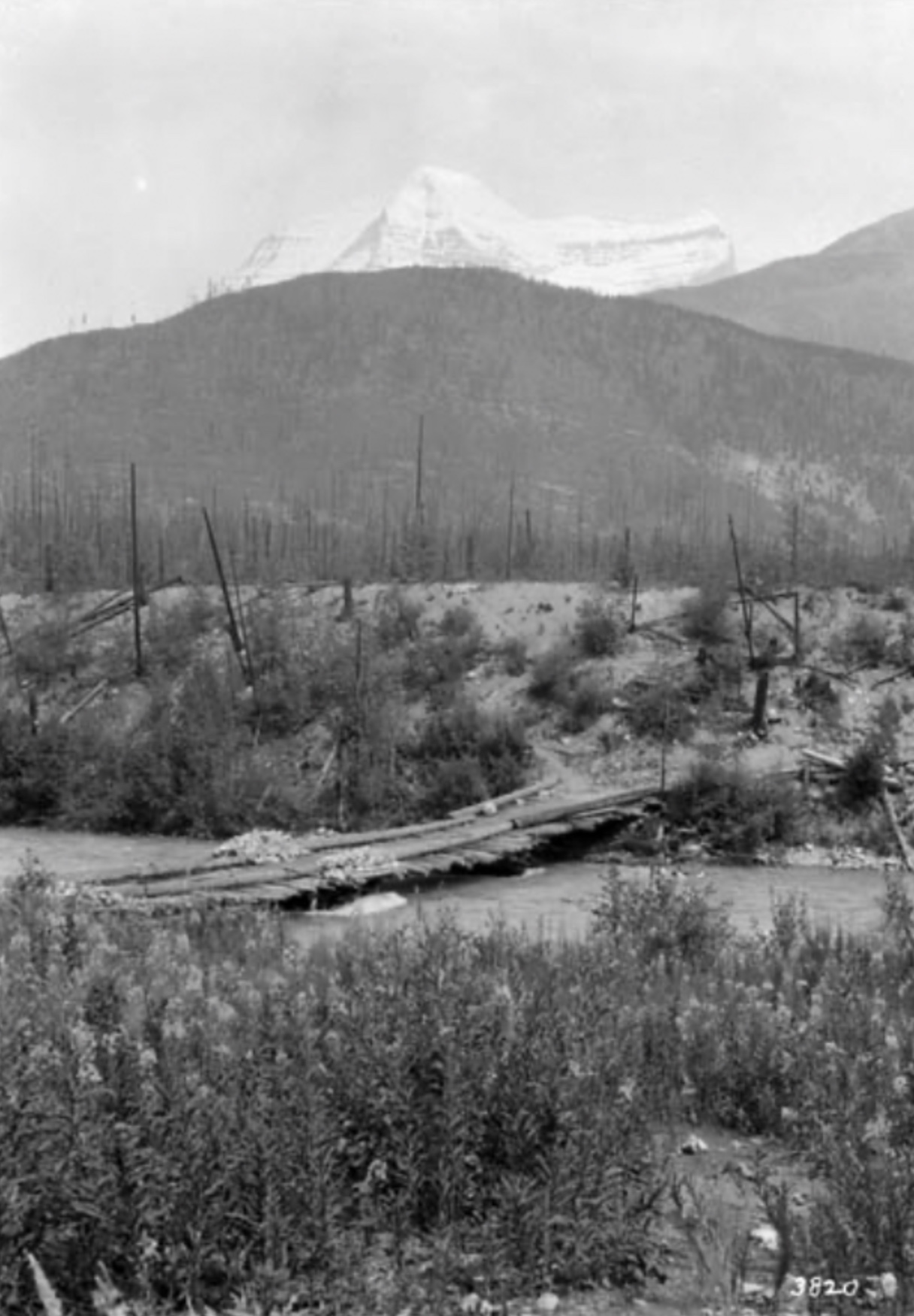Former name of Klapperhorn Mountain
Not currently an official name.

At Hogan’s bridge – Mt. Robson in background
William James Topley, 1914
Library and Archives Canada

At Hogan’s bridge – Mt. Robson in background
William James Topley, 1914
Library and Archives Canada
During the construction of the Grand Trunk Pacific and the Canadian Northern railways in the 1910s, contractor Denny (or “Dinny”) Hogan had a camp below Overlander Falls, on both sides of the Fraser River. But is he associated with the naming of this creek, which is 20 km to the south? [See the comment below.]
Feature type: road
Province: British Columbia
Location: Loops S off Hwy 16 E of McBride
Latitude: 53.2699 N
Longitude: 120.0626 W
Google Maps
Alberta native Arthur Hinkelman (born 1911) came to the McBride area in 1928. After twenty years of farming and two year of carpentry, he went to work in the logging industry as a log scaler and lumber grader. He was secretary of the Beaver School District for four years, and president of the McBride Farmers’ Institute for five years.

Henningville (Mile 49), Tête Jaune area
Valemount & Area Museum
The company of Palmer Brother and Henning were construction contractors during the construction of the Canadian Northern Pacific Railway through the Yellowhead Pass and south down the Canoe River. Palmer Brother and Henning had a siding on the Grand Trunk Pacific line at Mile 49 (measured from the Alberta border), near Tête Jaune Cache, to service their camps.
In the years after 1912, Henningville grew into a small hamlet with a Canadian Northern Pacific warehouse and some dozen other buildings, including the Austin Brothers store, Cox’s post office, and a pool hall. The name Henningville was rarely used, because the railroaders all called the location “49.”
In the Tête Jaune Cache area, on the Grand Trunk Pacific, people lived in several communities: Mile 53, where the Siems-Carey and the Foley, Welsh and Stewart wharves bordered the Fraser River, Mile 52, where the new train station, Main Street and the red-light district were, Mile 51, where a ship-building yard had been set up to rebuild two sternwheelers, originally from Victoria, B.C., and Mile 49, later to be known as Henningville.
Tête Jaune Cache magistrate William A. Jowett noted in his diary in June, 1914: “To 49 for Henning’s surprise party on his return from being married with Bel and had a good time!”
The Henningville post office opened in 1913; in 1917 the name was changed to Tête Jaune Cache.
Descriptive.

James Shand-Harvey with horse in smudge, Smithsonian-ACC Robson expedition, 1911
Whyte Museum of the Canadian Rockies
Perhaps named for James Shand Harvey [1880–1968], who spent decades as a guide and packer in the area around the Yellowhead Pass and Téte Jaune Cache and retired to a cabin near Entrance, Alberta.
Harvey was born in Scotland, the son of a wealthy family who owned the Castle Semple estate in Lochwinnoch, Renfrewshire. He left behind his life of privilege and wealth and emigrated to Canada, arriving in Edmonton in 1905. After a brief stint at homesteading, he worked on surveys for the Grand Trunk Pacific Railway, and for the Dominion Land Survey on the 14th base line from Lac Ste. Anne to Jasper. In 1909, he guided Arnold Louis Mumm [1859–1927] on a mountaineering expedition from Wolf Creek to their rendezvous with John Yates, and accompanied the expedition to Mount Robson. By 1911, with a few horses of his own, he hauled supplies from Lac Ste. Anne to Tête Jaune Cache.
He was assistant packer to Donald “Curly” Phillips [1884–1938] on the 1911 Alpine Club of Canada–Smithsonian Robson Expedition.
In the winter of 1917, Shand Harvey accompanied Phillips and Mary Lenore Jobe Akeley [1878–1966] on their trip to the Wapiti River. Shand Harvey later became a forest ranger and fire warden in the Grande Cache district of Alberta.
In 1921 he built a cabin near Entrance, at the east boundary of Jasper National Park, and trapped in the surrounding hills. James MacGregor’s book Pack Saddles to Tête Jaune Cache is about Shand Harvey.